Boy, howdy, we got birds

These are actually from several different shooting sessions, and the first here is from May, a grab shot as a red-shouldered hawk (Buteo lineatus) cruised by near the sun – I just liked how the feathers turned out, though this gives a rotten impression of the actual coloration. I’ve had this sitting in the folder for a couple of weeks and decided to feature it with the others.
That was from the nearby pond, so let’s feature the other two from that location (though a different day) before we move on to Jordan Lake.

As I rounded the bend in the shoreline and came into view, I saw a grey squirrel immediately vacating the area while a female eastern bluebird (Sialia sialis) hovered agitatedly nearby. Before I brought the camera to bear, the female flew a short distance off while the male, seen here, sat outside the nest box and looked around for quite a while. I got the impression the squirrel might have been trying to raid the nest box and got driven off, but I didn’t know if the box was occupied – I’m guessing yes, from the behavior, though it’s late in the nesting season. I tried staking it out, but both the male and female seemed quite aware of my presence and refused to go near the box while I waited, even though I was a decent distance off. The female gave me some nice poses, and from this angle the impression given is quite expressive.
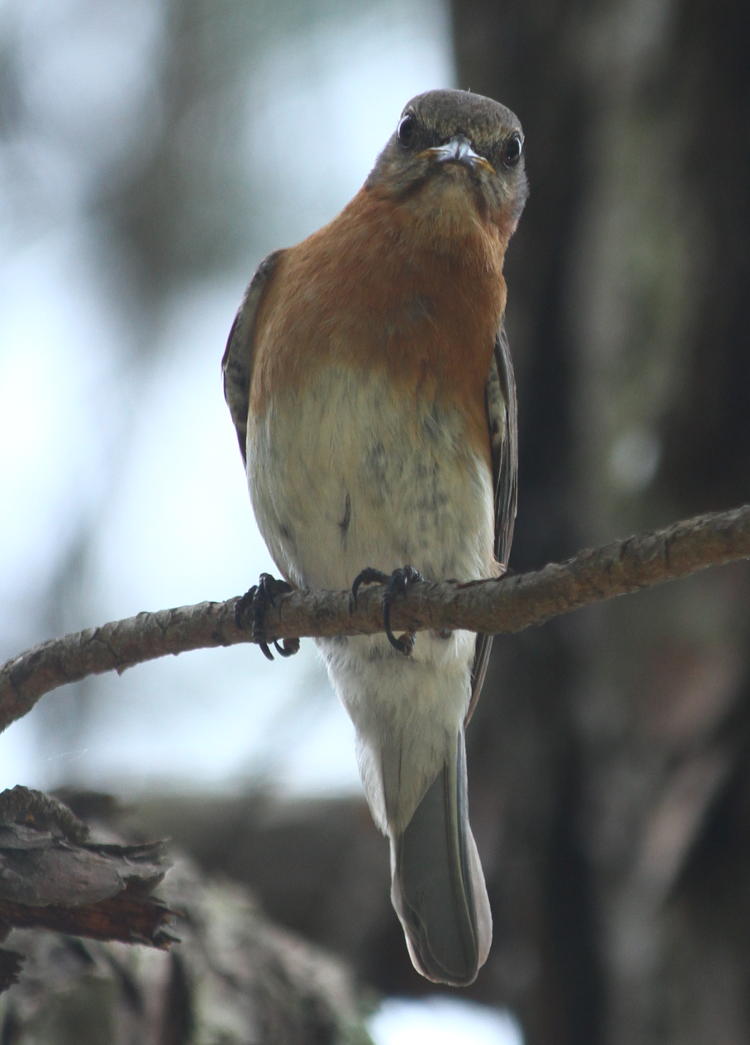
Note that this is a tighter crop from the 100-300 L lens, so I wasn’t all that close – a solid eight meters, at least.
Now we go down to Jordan Lake, because Jordan Lake is where it’s at.
[Well, okay, Venice Rookery is where it’s at, but that’s a bit more than a day trip from here, so Jordan Lake is the reasonable substitute for bird photos around here.]
A session a little over a week ago yielded only a few decent pics, since the activity was a bit sparse, which is how it goes – this was partially because it was a Saturday and there were lots of people out on the lake, pushing the bird activity further away from our location (this meaning the Indurate Mr Bugg and I.) The sunrise had been crappy, but eventually produced some better light, and I snagged a cruising great blue heron (Ardea herodias) that wasn’t too unfocused.
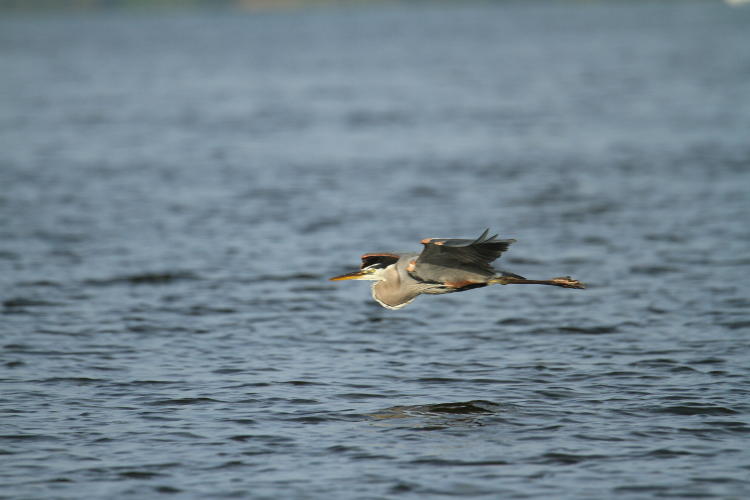
For the most part, the ospreys (Pandion haliaetus) kept their distance and did almost no hunting; the one example that I photographed had the autofocus getting fooled by the background again, and I missed some good shots, though granted, they were at a distance anyway. I include the one below more out of curiosity than anything.
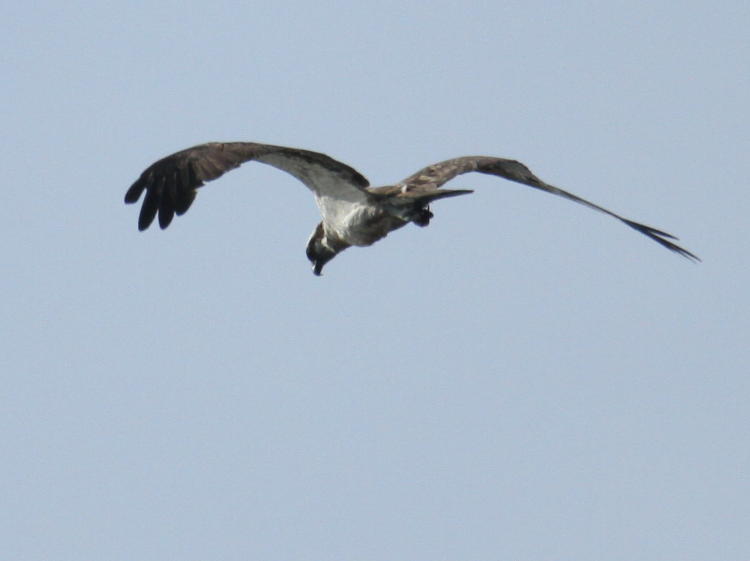
That’s… awful lean looking for a healthy osprey, so this is either one that’s not doing too well, or (my suspicion) a newly-fledged youngster, since it’s that time of year. A juvenile bald eagle cruised past in the same session, though too distant and at a crummy angle to make worthwhile photos.
A week later (which means a few days back now) we returned, and this time things were slightly better, even though the sky was scattered overcast with occasional rays of sunshine. Early on, another osprey started its dive as I followed it.
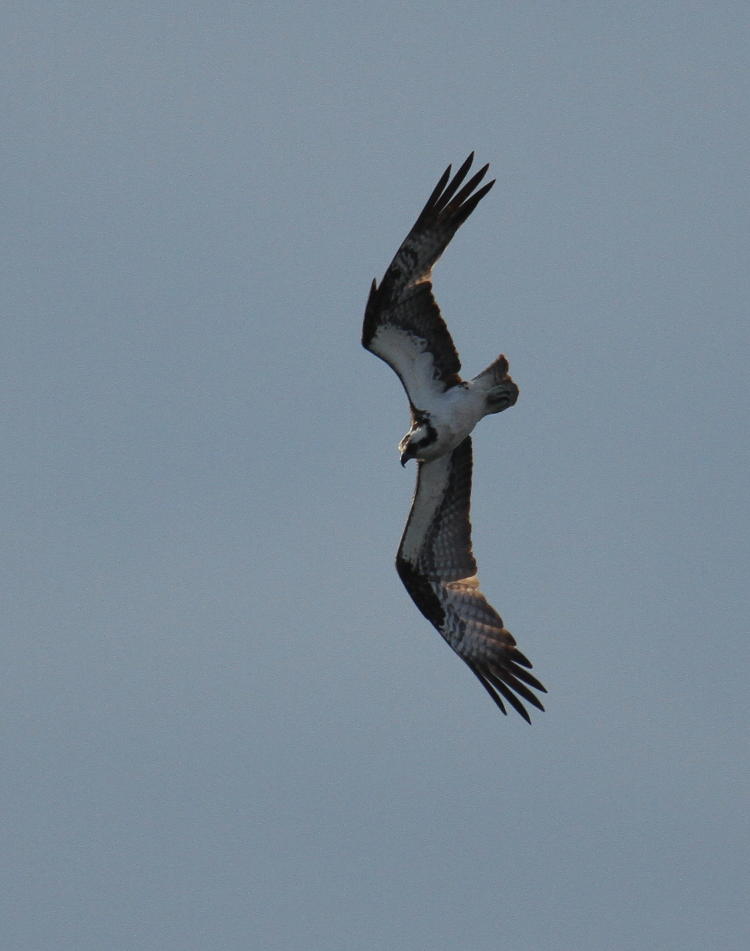
The act of a raptor diving for food is called a stoop, by the way, but don’t ask me why. You can just see the hints of gold backlighting – birds aren’t always cooperative in positioning themselves in the best light.
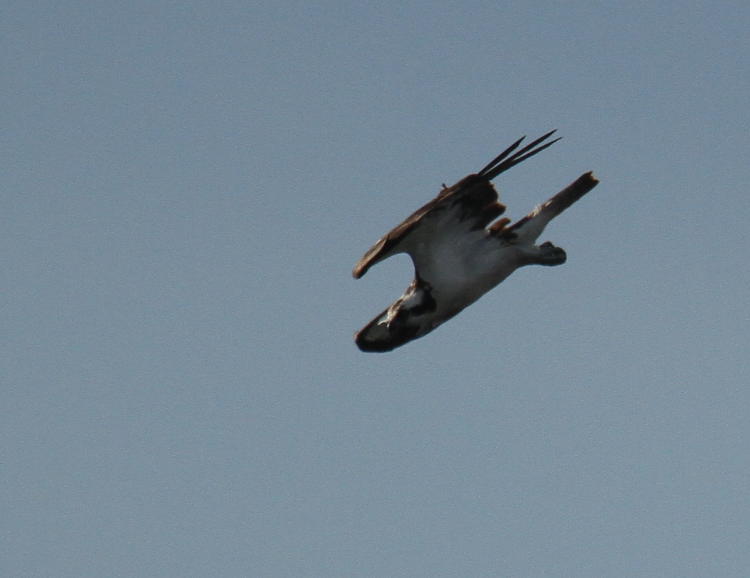
First off, the birds may see prey anywhere, so it’s hard to position oneself with the light behind you, falling on the bird better, but in this case, getting the early morning sun behind us would have required being perched on the jumbled large rocks of an artificial causeway, in full sunlight and view, unable to move much without risking a nasty fall.
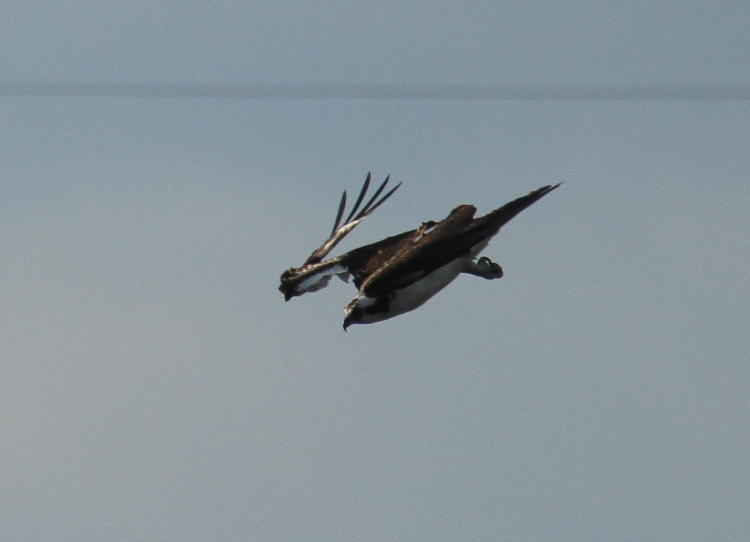
Here, it passed against the power lines that ran down the causeway. I hate power lines; always getting in the photos, and always coming down in storms. Bury the damn things.
By the way, I have considered a shooting blind on something like a raft for subjects of this nature, but again, the birds can appear anywhere, at any angle, so the best that could be used is a half-tent that wouldn’t disguise much movement and wouldn’t shield from the sun for very long – not worth the effort. Most photography blinds are for known, semi-fixed subjects close to ground level.
At this point, the osprey still hasn’t veered off, which happens more often than not in my experience, as the fish goes deeper.
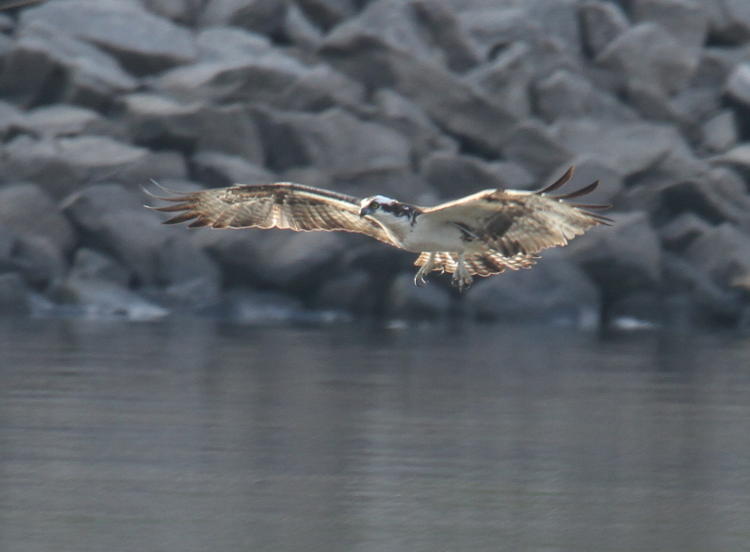
Closing in, and the autofocus nailed it solidly – for a moment, at least. Nice accent lighting and position here. And you can see the causeway rocks I mentioned.
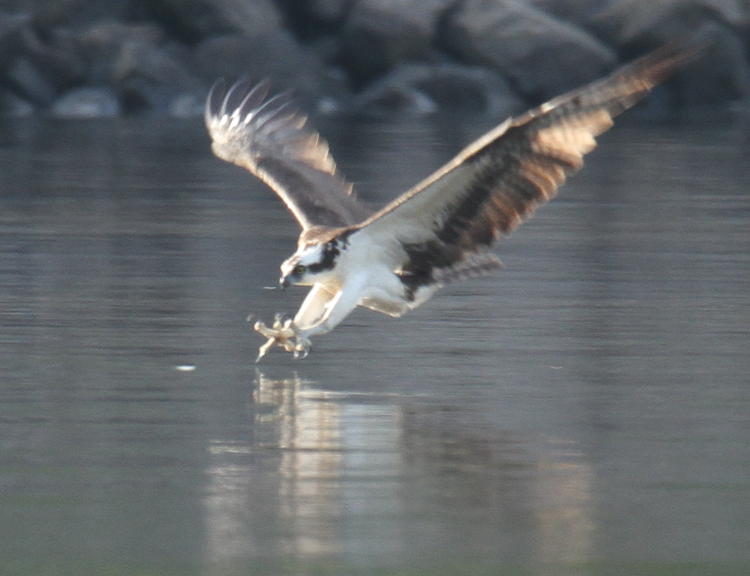
And then, the AF slipped a little, just as the osprey was making its capture – it’s not more than a few millimeters from contacting the water here. It’s all happening fast, so all I can do is trip the shutter and try to keep the bird in the autofocus area. But let’s get an establishing look too.
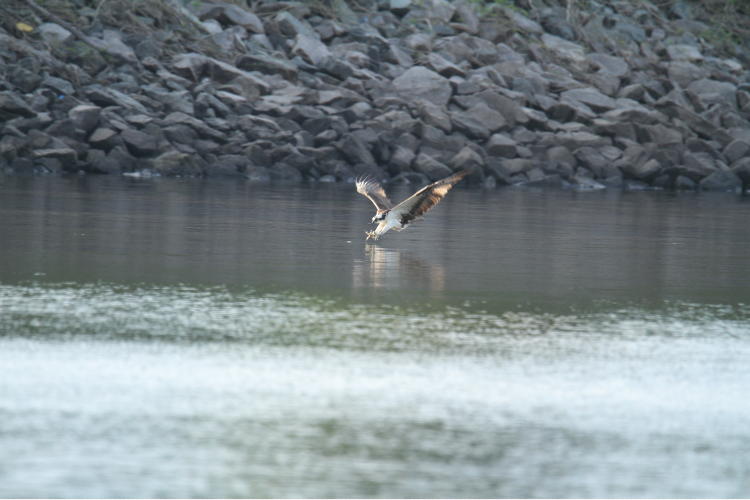
This is the same image, but full frame – reduce this whole thing down a bit just to demonstrate what I could see in the viewfinder. This is an estimated 100 meters away, too, at 600mm focal length. I’ve tried willing them closer, but it hasn’t worked – so much for telekinesis. The osprey looks closer to the rocks, giving weight to the idea of clambering on them for better pics, but there’s nothing for scale in there either, and I’m pretty certain it was closer to us than to them.
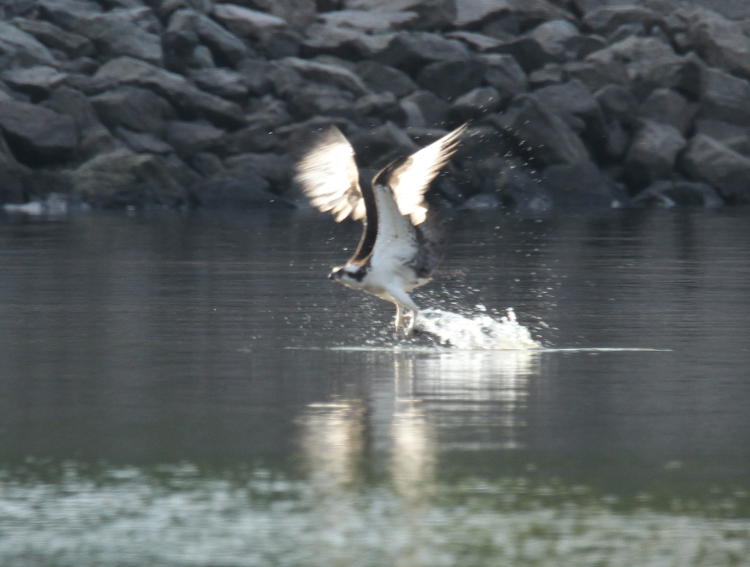
Even worse focus here, slipping in fractions of a second – you can see why I’m not a big fan of autofocus, even though at times it definitely makes things easier; it’s just too easy to fool and wander. Very often, osprey slam into the water, almost completely submerging themselves, but this time around it merely scooped the fish from the surface daintily.
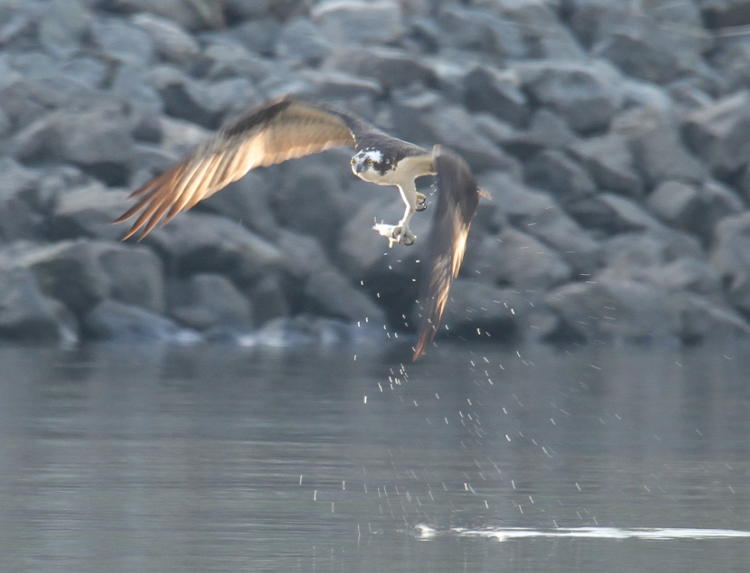
AF came back almost adequately for a moment as the osprey climbed out, and the backlighting at least highlighted the dripping water.

And cooperatively, the osprey bore directly down on us for a few seconds, perhaps thinking it would perch in the trees we stood among, before it veered off and circled around for a bit. I’m not down there enough to know if there are ‘typical’ perches for specific birds, though I will say that a bald eagle was found in the exact same tree for both session, lending some weight to the idea. That one was over a kilometer off across the lake, so those pics are only proof of presence and not worth posting (and I say that after posting these, so…)
While we were there, we stood near a dead stump that housed an active brown-headed nuthatch (Sitta pusilla) nest, and watched the feeding behavior, proof of occupancy.
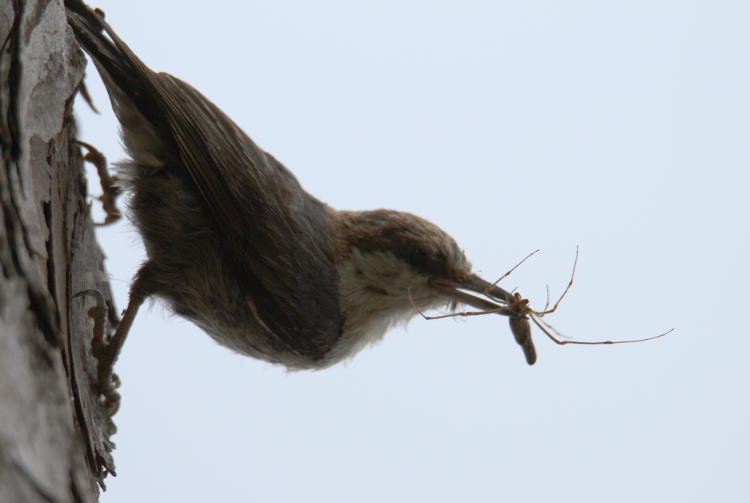
Most of the times when the parents came around, they had a small inchworm or some tiny unidentifiable flying insect, but we got lucky once and watched it bring in a long-jawed orbweaver, a common spider around water sources, and being only a handful of meters away, we could get nice clear shots – though both in shadow and backlit by a clouded sky.
I could see that the parents weren’t leaning very far in and figured that the young was/were getting big, so I waded into the water for a more head-on view. The previous week we’d been watching the same nest, but the water level was half a meter higher then (after-effect of several hard rains immediately beforehand) so wading was out of the question; I hadn’t brought a swimsuit and wouldn’t have chanced it with the camera equipment anyway. Now that it had dropped to calf-depth and I could at least see what might trip me, I could go for the better angle.
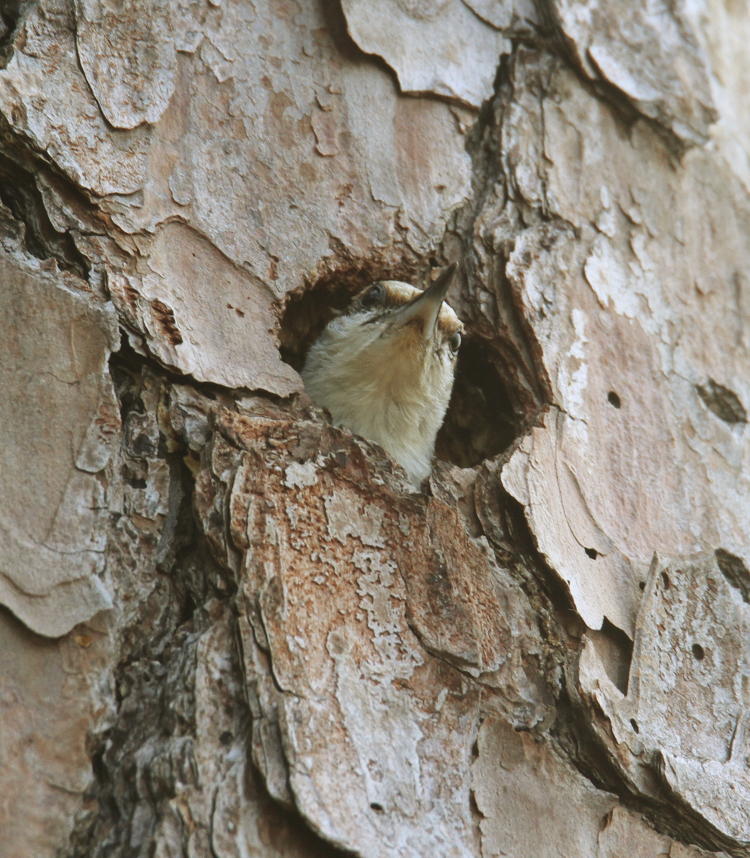
This is the parent, having disappeared completely into the nest and then peeking back out again a few moments later; I never did see any of the nestlings. Late afternoon sun would have shown much better, but the session hadn’t been scheduled then. However, I may be making a trip like that soon so we’ll see what happens. The young might even have fledged out before then.
The point where we were shooting from is a great favorite of the vultures – despite the efforts of the Wildlife Resource Commission, which attempted a ‘vulture effigy’ program to discourage them. I find this amusing, so bear with me a second. Last year, we started seeing dead vultures hanging from several trees in the vicinity, and signs posted nearby indicated this was a vulture effigy program intended to scare them off from roosting in the area, citing… well, I’ll let you read it.
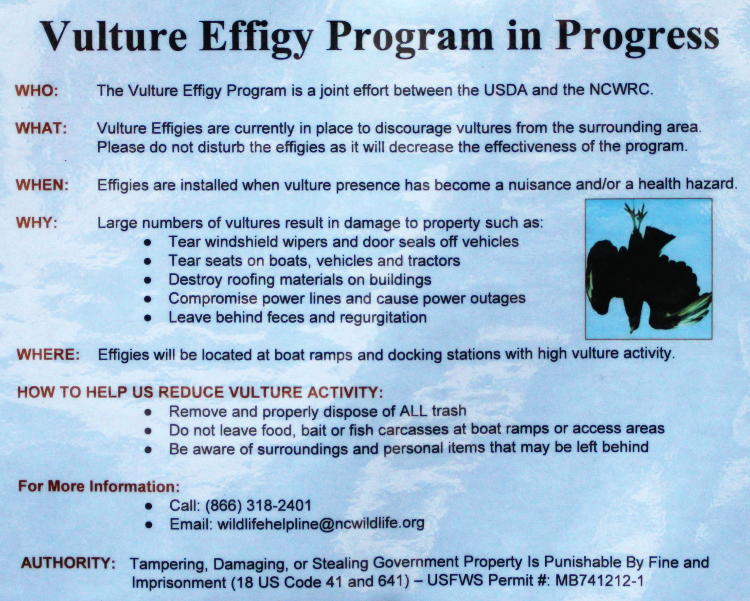
In case it still comes up too small, I’ll point out that they’re claiming vultures, and I quote, “Tear windshield wipers and door seals off vehicles,” and “Tear seats on boats, vehicles, and tractors.” Which is, in a word, utter horseshit – vultures don’t like people very close and choose safe, high perches everywhere available. They don’t perch on cars or boats unless said vehicles have been sitting there for days/weeks, and there’s no place else for them to perch – certainly not the case at Jordan Lake. Also cited are feces and regurgitation, and I can tell you I stand routinely under favored trees and see very little evidence of feces – herons are far worse culprits – while vultures regurgitate when they’re threatened. I’m far more inclined to believe this is the NCWRC bowing to exaggerated (or outright fabricated) farmer complaints than any real measurable issues. About the only authentic issue that I see is the one about power lines, and I addressed that above ;-). Plus, of course, their program doesn’t work anyway.

See that ragged mass in the upper left corner? That’s there vulture ‘effigy,’ which is their way of trying to pretend it’s not actually a dead vulture, and how these are obtained is not clear, but I’ll go ahead and surmise that the agents of the NCWRC aren’t scouting around until they find handy dead ones. See the black shapes on the beach below? Those are the live, unimpressed vultures – which eat carrion as a matter of course, so aren’t particularly put off by dead things and aren’t taking this as a warning or threat. And mind you, this was last year when the program was ‘fresh,’ if you’ll pardon me for using that word.
Want to know why the vultures congregate in this particular area? Because of natural fish kills washing up on the shores, and of course, people discarding fish carcasses or portions thereof on the banks as well. I always see dismembered fish on the sand there. Herons eat fish whole, as do most of the rest of the predators in the area. Fish heads come from fishermen.
Anyway, the vultures continue to be unimpressed.

Here, a small flock of turkey vultures eyed us warily, but we were doing the nature photographer thing and being quiet and unobtrusive – had we clapped our hands, they were have taken flight immediately. And remember, long lenses? Yeah, they’re a good ways overhead.
Another, this time a black vulture (Coragyps atratus,) came to rest in a dead tree on the point, fairly close to directly overhead, though looking down on us uneasily as we quietly conversed.

After a couple of minutes, it decided we were too close after all and flew off for a quieter perch. But as another passed, I fired off a few frames and got a nice display of their plumage, specifically the distinctive wing coloration.
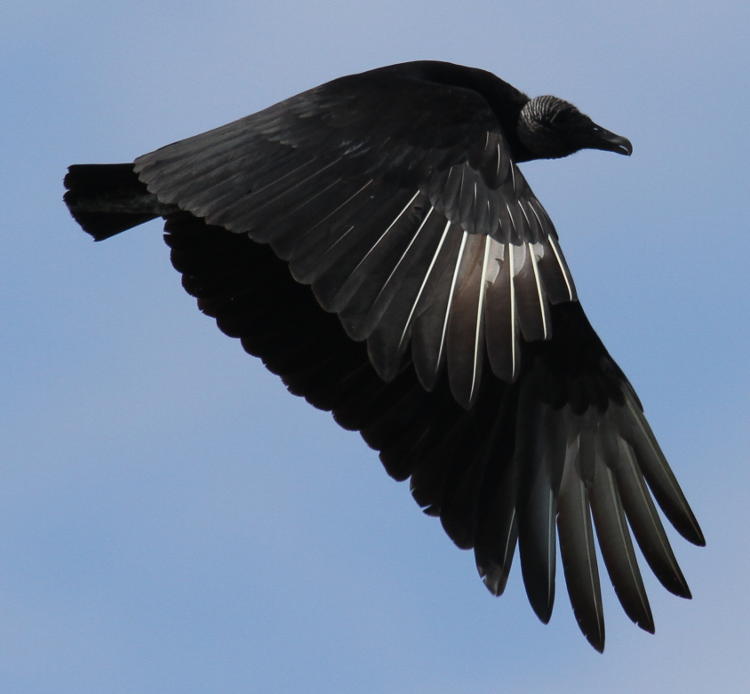
The white shafts and deep grey feathers on the outermost flight feathers of the wings give them pale ‘palms,’ which is how to easily differentiate this species from the turkey vultures in flight – the differently-colored heads are way too small to make out clearly at a distance. Turkey vultures have silvery-grey flight feathers all along the wings, giving them a grey trailing edge, and longer tail feathers than this.
But enough about vultures. Let’s do herons for a bit.
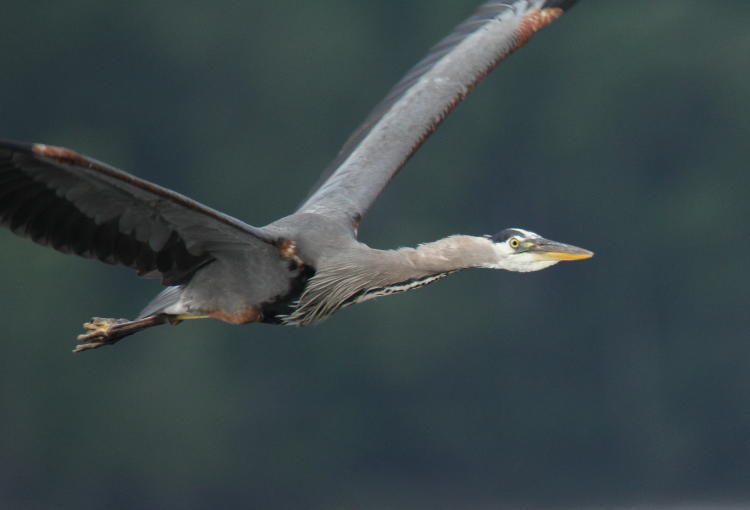
Herons don’t generally fly with their necks extended, but this one had just been spooked from a foraging spot and was on its takeoff run, the only shot from a sequence that the AF worked as intended, and that was badly framed. The sequence shows the neck gradually retracting into the folded position seen further up in the post – it’s kind of like retracting the landing gear.
Another that I followed showed much the same difficulties in AF tracking, with two notable exceptions, both looking the same:

Sure, thanks, lock on once the head is hidden behind the wing – good job.
[Some of this is due to my movement, and an inability to maintain the bird in a smallish AF spot, and there are partial solutions to this. One: getting steadier, which I’m working on, but it’s a heavy rig held with my arms semi-extended, so there’s a limit. Two: shooting from a tripod, or at least a monopod, but those are only good for subjects no more than 20° above the horizon, and the osprey photos above thwarted that for all but the middle photos. Three: selecting a wider AF area, but that generally means the camera chooses which point to lock onto, and as it crosses a horizon line or in front of a higher-contrast background, it’s too likely to lock onto that and not switch back to the bird until too late. And finally, I have further options for AF behavior from the camera body, and I am trying them out to see if any works noticeably better.]
Another got spooked by a passing boat and did this halfhearted flight only a handful of meters, landing in deeper water than it seemed to expect.

But at least autofocus decided to work accurately here. You know, on a subject I could easily have manually focused upon…
For the last few, we return to the ospreys, showing the changing light conditions of the day.
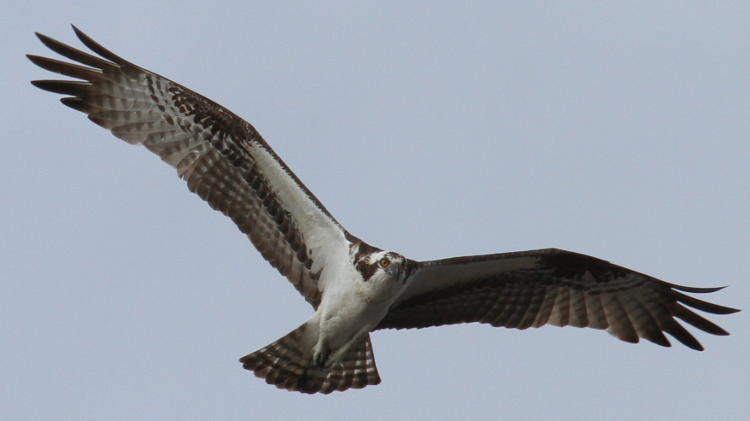
Early in the day, we had largely overcast skies, with small break here and there but not letting direct sunlight through except in very select patches. Okay for contrast control, but not for colors, shutter speed, or interesting skies. And naturally the ospreys that drew closest didn’t deign to go fishing at that distance. Ingrates.
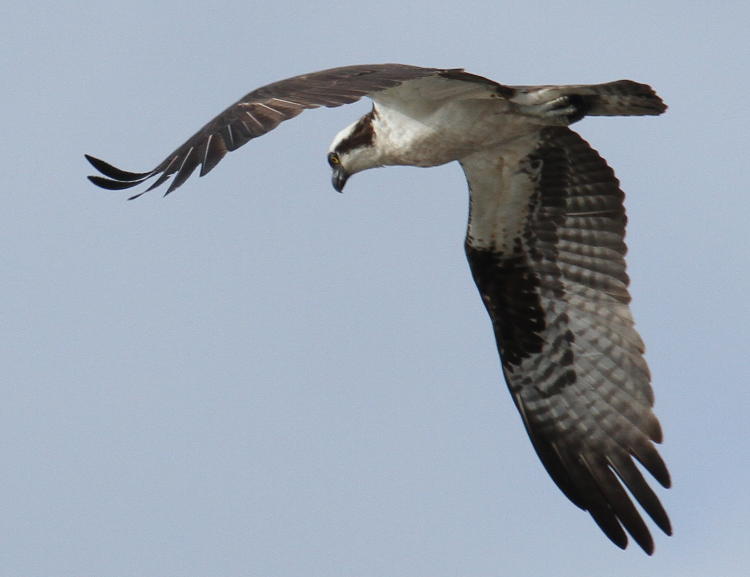
As the day wore on, the patches of sunlight grew, occasionally throwing some low-contrast, diffuse light onto our subjects. I happened to like this one for the curves of the wings, but the distinct shadow at least hints at a nicer day. There were small patches of blue to be found in the sky, but it was a matter of luck and timing to get a bird framed against one, and it always lasted a second or less.
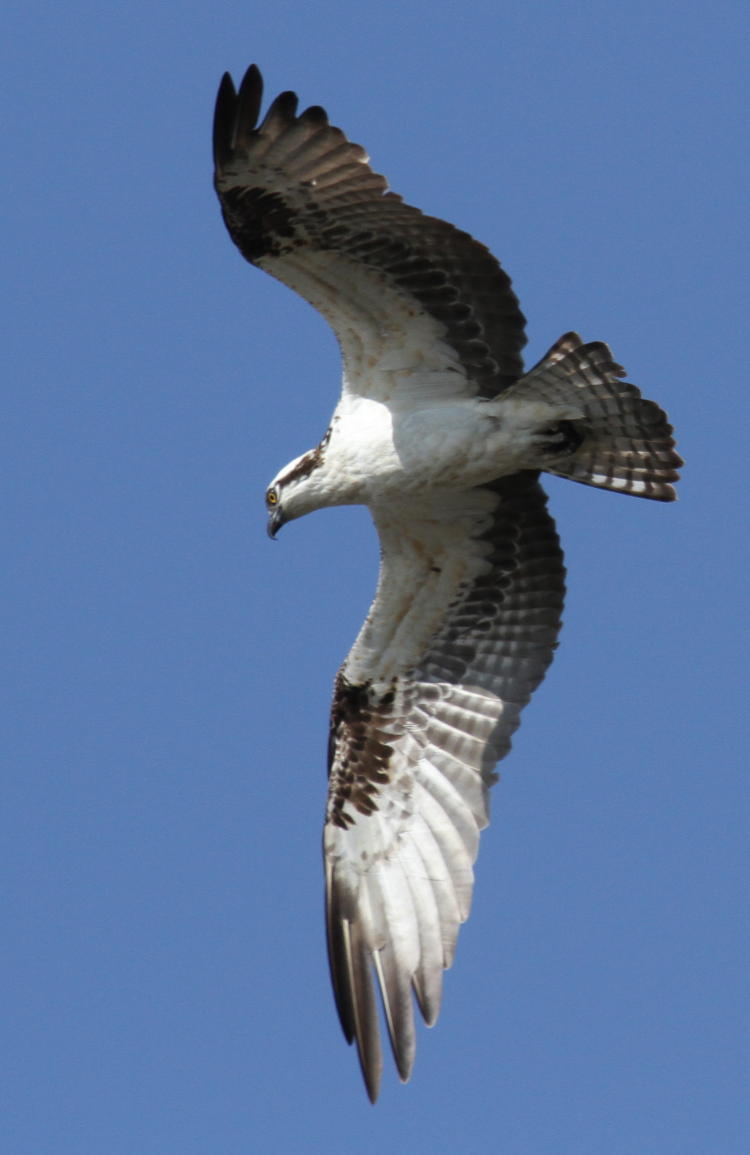
Eventually, the day cleared much better, at least giving nice color to the backgrounds, but note that good light angles have now narrowed down a lot, because it becomes very easy to have a bird backlit and see nothing but a shadowed underside, so timing becomes much more crucial the brighter it gets, and I tend to follow birds until they bank the right way. This is roughly 90° off the sun, so the sky isn’t devolving into washed-out glare (like in the first image in this post,) but it’s less ideal than say, 150° to 230° off, more directly lit. The docks lay that way from our position, so the birds were less likely to be there. What we need is a nice shady island with lots of fish around, but no boaters. And while I’m wishing for silly things, birds that take direction and a sun that can be positioned at will. But I guess if it was easy, I’d have none of the remarkable prestige that I now garner from being a nature photographer…



















































